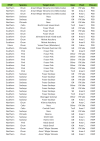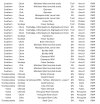Note, not a Steelhead on the report.
Yup! And that's sad, isn't it OBD? Like the Thompson and Chilcotin steelhead populations as assessed as Endangered by COSEWIC which recommended an emergency listing order under the federal
Species at Risk Act. Want some more bad news (prob. not):
Under COSEWIC (but NOT necessarily out from SARA and NOT necessarily thru the Fisheries Minister - 2 more steps) these Chinook species/populations alone are also listed as either "Endangered" or "Threatened" or "Special Concern": (NOTE: "GIC decision Pending" means "Governor in Council", or... in reality - DFO:
Chinook Salmon East Vancouver Island, Ocean, Fall population Special Concern GIC decision Pending
Chinook Salmon East Vancouver Island, Ocean, Summer population Endangered GIC decision Pending
Chinook Salmon East Vancouver Island, Stream, Spring population Endangered GIC decision Pending
Chinook Salmon Lower Fraser, Ocean, Fall population Threatened GIC decision Pending
Chinook Salmon Lower Fraser, Ocean, Summer population Endangered GIC decision Pending
Chinook Salmon Lower Fraser, Stream, Spring population Special Concern GIC decision Pending
Chinook Salmon Lower Fraser, Stream, Summer (Upper Pitt) population Endangered GIC decision Pending
Chinook Salmon Lower Fraser, Stream, Summer population Threatened GIC decision Pending
Chinook Salmon Lower Thompson, Stream, Spring population Endangered GIC decision Pending
Chinook Salmon Middle Fraser, Stream, Fall population Endangered GIC decision Pending
Chinook Salmon Chinook Salmon Middle Fraser, Stream, Spring (MFR+GStr) population Threatened GIC decision Pending
Chinook Salmon Chinook Salmon Middle Fraser, Stream, Spring population Endangered GIC decision Pending
Chinook Salmon Middle Fraser, Stream, Summer population Threatened GIC decision Pending
Chinook Salmon North Thompson, Stream, Spring population Endangered GIC decision Pending
Chinook North Thompson, Stream, Summer population Endangered GIC decision Pending
Chinook Okanagan population Endangered GIC decision Pending
Chinook Salmon South Thompson, Stream, Summer 1.2 population Endangered GIC decision Pending
Chinook Salmon South Thompson, Stream, Summer 1.3 population Endangered GIC decision Pending
Chinook Southern Mainland Boundary Bay, Ocean, Fall population Threatened GIC decision Pending
Chinook Salmon Upper Fraser, Stream, Spring population Endangered GIC decision Pending
Chinook Salmon West Vancouver Island, Ocean, Fall (Nootka & Kyuquot) population Threatened GIC decision Pending
Chinook Salmon West Vancouver Island, Ocean, Fall (South) population Threatened GIC decision Pending
So - couple questions:
1/ are all those above-listed Fraser Chinook populations covered under the title: "
Summer 4.1"? Cause that's what's listed for Fraser Chinook in PSSI, and
2/ would the West Vancouver Island, Ocean, Fall (Nootka & Kyuquot) populations hang-out near the pens on WCVI?
And out of all that COSEWIC status reports - Here's the all the ones that made it past SARA and the Fisheries Minister:
Maybe best to take that high blood pressure pill, or a couple shots of Scotch - or both...
Anyways back onto FFs...






